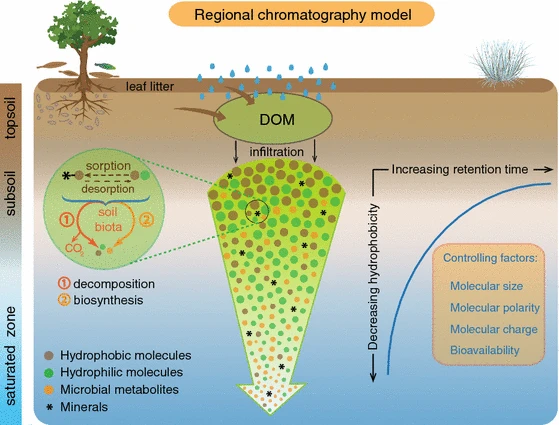Origins_and_bioavailability_of_dissolved_organic_matter_in_groundwater.webp
Summary
| Description Origins and bioavailability of dissolved organic matter in groundwater.webp |
English:
Origins and bioavailability of dissolved organic matter in groundwater
Regional Chromatography Model—precipitation and surface water leaches dissolved organic matter (DOM) from vegetation and plant litter and percolates through the soil column to the saturated zone. The concentration, composition, and bioavailability of DOM are altered during transport through the soil column by various physicochemical and biological processes, including sorption, desorption, biodegradation and biosynthesis. Hydrophobic molecules are preferentially partitioned onto soil minerals and have a longer retention time in soils than hydrophilic molecules. The hydrophobicity and retention time of colloids and dissolved molecules in soils are controlled by their size, polarity, charge, and bioavailability. Bioavailable DOM is subjected to microbial decomposition, resulting in a reduction in size and molecular weight. Novel molecules are synthesized by soil microbes, and some of these metabolites enter the DOM reservoir in groundwater |
| Date | |
| Source | doi : 10.1007/s10533-014-0029-4 |
| Author | Yuan Shen, Francis H. Chapelle, Eric W. Strom & Ronald Benner |
Licensing
This file is licensed under the
Creative Commons
Attribution-Share Alike 4.0 International
license.
-
You are free:
- to share – to copy, distribute and transmit the work
- to remix – to adapt the work
-
Under the following conditions:
- attribution – You must give appropriate credit, provide a link to the license, and indicate if changes were made. You may do so in any reasonable manner, but not in any way that suggests the licensor endorses you or your use.
- share alike – If you remix, transform, or build upon the material, you must distribute your contributions under the same or compatible license as the original.
Captions
Origins and bioavailability of dissolved organic matter in groundwater

